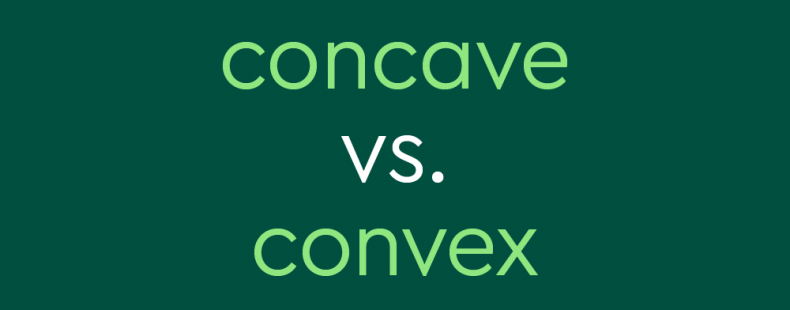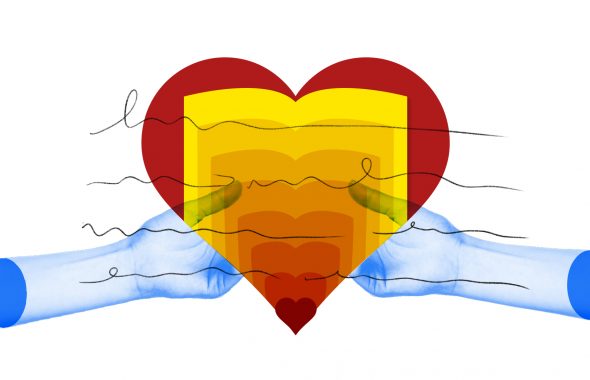Concave and convex are literal opposites—one involves shapes that curve inward and the other involves shapes that curve outward. The terms can be used generally, but they’re often used in technical, scientific, and geometric contexts. Lenses, such as those used in eyeglasses, magnifying glasses, binoculars, and cameras are often described as concave or convex, depending on which way they curve. In geometry, both words can be used to describe the shape of polygons, depending on whether they have any inward-facing angles.
Not only will this article help you remember which is which, you’ll also learn a little bit of the science behind why concave and convex shapes create different optical effects in lenses and mirrors.
⚡️Quick summary
Concave means curving inward—like the shape of the inside of a bowl. Convex means curving outward—like the shape of the outside of a contact lens. To put it another way, a concave shape can be filled, while a convex shape creates a dome.
What does concave mean?
Concave means “curving inward” or “hollow and curved,” like the inside of a bowl, or, more technically, the inside of a partial sphere. A crater is roughly concave.
What does convex mean?
Convex means “having a surface that is curved or rounded outward,” like the outside of a contact lens (the part that a person touches when putting it on their eye). A mound is roughly convex.
How do you measure that outward curve though? Learn the ins and outs of the ratio pi to find out.
Concave vs. convex lenses
Concave lenses—those that are thicker around the edges than they are in the center—disperse light rays, which can have the effect of making things look smaller or farther away. Convex lenses—those that dome outward and are thicker in the center than they are around the edges—make light rays converge. Convex lenses have the opposite effect of concave ones: they can make things look closer or bigger.
https://t.co/4bdwrNR8Kk
A lens is a transparent medium bound by two surfaces.
There are mainly two types of lens. 1) Convex lens 2) Concave lens pic.twitter.com/no0CJUUhq0— Education Zone (@EducationZone11) December 10, 2018
Magnifying glasses and some binoculars use convex lenses. Concave lenses are used in movie projectors to spread out the image onto the screen (if you look back through the lens, inside the projector, the image will look tiny). Some optical devices, like telephoto lenses for cameras, use a combination of concave and convex lenses.
Concave lenses are used in eyeglasses for people who are nearsighted (those who have trouble seeing things that are far away). Convex lenses are used in glasses for people who are farsighted (those who can’t see things very well up close). This may seem counterintuitive, but it all has to do with how the lenses help the image get processed by the eye.
Convex lenses sometimes have the effect of inverting far-away images. Many binoculars that use convex lenses solve this issue through the use of prisms that turn the image right-side up. A similar thing happens with your eyes. Because the eyeball is curved, the images that pass through it are inverted, and the brain has to flip them so you can see them the right way.
Concave vs. convex mirrors
Convex mirrors have the effect of making things look farther away and allowing for a field of view that’s wider than the one you would normally be able to see. Most cars have convex passenger side mirrors that allow the driver to see objects that would normally be in the vehicle’s blind spot. This is why the mirror says Objects in mirror are closer than they appear (they look farther away than they actually are).
Concave mirrors—like that one they stick in your mouth at the dentist’s office—are used for close-up work because they make the things they reflect easier to see by making them look bigger.
Reflective objects that are concave have the ability to invert the images they reflect. Grab a spoon from the silverware drawer and you can see this in action. When you look at the concave part of the spoon—the bowl part that you scoop up soup with—you’ll see that your reflection is upside down. The concave side shows an upside-down image because the top part reflects light downward and the bottom part reflects light upward. Flip the spoon over to the convex side and your reflection will be upright.
Concave vs. convex polygons
In geometry, concave has a more specific meaning that’s used to describe the shape of a polygon (multi-sided figure) that has at least one interior angle greater than 180 degrees (translation: it’s a shape with at least one inward angle). Convex polygons are those in which all the angles are no greater than 180 degrees—meaning that none of them point inward.
For example, a classic star shape is a concave polygon because each of the arms of the star comes inward to produce an inward-facing angle. An octagon—like a stop sign—is a convex polygon, because all of its angles point outward.
Where do the words concave and convex come from?
Concave comes from the Latin concavus, meaning “arched” or “hollow,” from the root cavus, which also means “hollow” and is also the basis of the word cave. Convex comes from the Latin convexus, meaning “vaulted” or “rounded.”
How to use concave vs. convex
Here’s the best way to remember the difference: concave things curve or turn inward, like the inside of a cave. Convex things curve or turn outward—regular hexagons are excellent examples of convex polygons.
Of course, generally speaking, some shapes could be considered both concave and convex depending on how you’re looking at them. In a semicircle, for example, the part that curves inward is concave, and the part that curves outward is convex.
Examples of concave and convex used in a sentence
Concave and convex are mostly used in technical, scientific, and geometric contexts. You might use them in everyday descriptions, but you’re more likely to use less formal words like rounded or curved. Still, they may be the best way to be clear about the shape of something.
- Our company manufactures convex lenses for a variety of applications, including telescopes and binoculars.
- The convex surface of the magnifying glass lens is what produces the magnification.
- Most of the basic polygons that you’re familiar with are convex polygons, including triangles, rectangles, pentagons, hexagons, and octagons.
- Many cameras use both concave lenses and convex lenses to provide the ability to zoom in and out.
- The description said the car has “several concave surface features”—which was a misleading way of saying “dents.”














